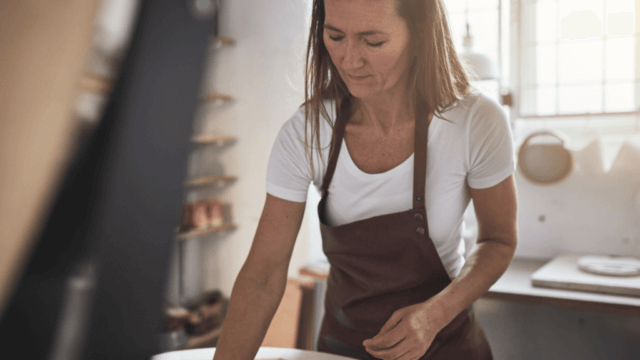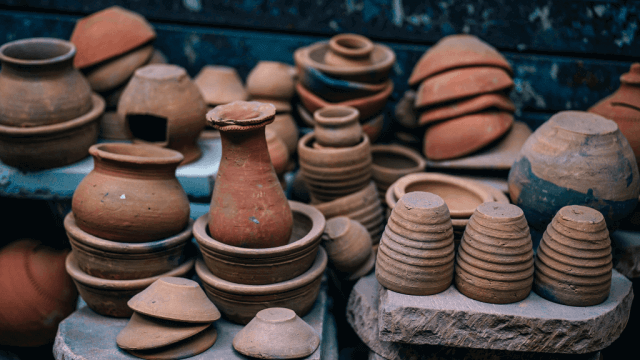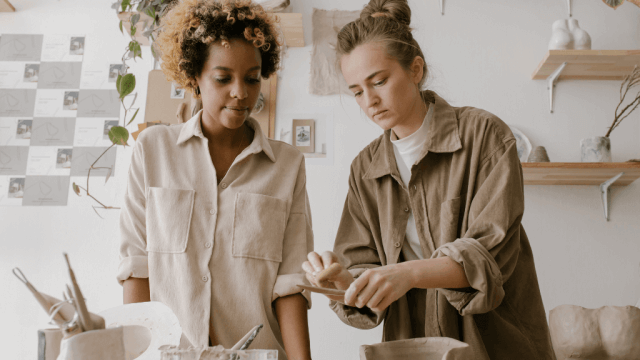You can fire your pottery at local ceramic studios, pottery classes, art centers, dedicated pottery kilns, or consider investing in a home kiln.
Some facilities may require fees or membership.
Research nearby options and contact them for further information and availability.
Finding a Place to Fire Your Pottery
Firing your pottery is a crucial part of the ceramic process, and finding the right place to do it can be challenging.
Below we explore the different options for firing your pottery and help you choose the best fit for your needs.
Local Ceramic Studios
Many local ceramic studios offer kiln facilities that can be used pay-per-use or as part of a pottery class or art center membership.
Use search engines or local directories to find a ceramic studio near you, and contact them for availability and pricing.
Community Art Centers
Community art centers or art schools often provide access to kiln facilities for members or students.
These centers might have scheduled firings; some even offer classes to guide you.
Contact your local art centers to inquire about pottery firing services and policies.
Community College or University Ceramics Programs
Many colleges and universities with ceramics programs offer community access to their facilities.
Contact the faculty or program coordinator to see if their kilns are available to the public and the procedure for accessing them.
Dedicated Pottery Kilns
Specialized pottery kilns operate solely to fire pottery.
These may offer different firings, such as cone or raku; some provide pottery storage while your piece awaits firing.
Use search engines or pottery forums to find a dedicated pottery kiln near you.
Purchasing a Home Kiln
If you plan to fire your pottery regularly, investing in a home kiln might be a cost-effective option.
Home kilns are available in various sizes and types, accommodating different firing temperatures and requirements.
Research the right model and installation process for your needs, and make sure to comply with local regulations and safety guidelines.
Firing Pottery at Home: Gas vs.
Electric Kilns
Gas kilns provide a rich and varied pottery firing experience and are often preferred for reduction firing.
Meanwhile, electric kilns are lower in cost and easier to operate, making them a popular choice for beginners.
Consider your overall pottery goals and available resources when making your home kiln decision.
Creating a Pottery Firing Cooperative
Another option for firing your pottery is to join or create a pottery firing cooperative.
This involves pooling resources with other local ceramic artists to rent or purchase a communal kiln.
In a cooperative, members share the costs of maintaining and operating the kiln, as well as help each other with the firing process.
Reach out to local pottery clubs or online communities to gauge interest and gather support.
Mobile Kiln Services
Some companies offer mobile kiln services, where the kiln is brought to your location for firing.
This service can be particularly helpful for group events, workshops, or if there are no nearby kiln facilities.
Check online or in pottery forums to find mobile kiln services operating in your area.
Scheduling and Preparing for a Mobile Kiln Firing
Be sure to plan and schedule your mobile kiln firing well in advance.
Gather your pottery pieces, prepare them for firing according to the service provider’s guidelines, and coordinate with other participants if it is a group event.
Ensure that the firing space meets all safety and logistical requirements outlined by the mobile kiln provider.
Alternative Firing Techniques
If traditional kiln facilities are difficult to access, you may want to explore alternative firing techniques.
Some options include pit firing, barrel firing, and raku firing.
While these methods may not be suitable for all types of pottery, they can produce unique and visually interesting pieces.
Pit Firing
Pit firing is an ancient method that involves building a fire in a pit and placing your pottery directly in the flames.
Fill the pit with combustible materials, such as sawdust, leaves, or wood, and carefully monitor the fire to achieve ideal temperatures.
Note that pit firing may not produce the same durability as a traditional kiln firing.
Barrel Firing
Barrel firing, similar to pit firing, uses an open flame to heat pottery in a controlled environment.
A sealed barrel holds the ceramic pieces and is layered with combustible materials.
Attach a vent or chimney to allow airflow, and manage the fire to attain desired temperatures.
Raku Firing
Raku firing is a Japanese technique known for its dramatic and unpredictable surface effects.
In a raku firing, pottery is heated in a special raku kiln until red-hot, then removed with tongs and placed in a container filled with combustible materials.
Once the materials ignite, the container is sealed, leaving the pottery to cool and produce unique patterns and colors.
Frequently Asked Questions about Firing Pottery
Here is a list of frequently asked questions to provide further guidance and information on the process of firing pottery.
These questions and answers will help you better understand the options available and important considerations to ensure success in your pottery firing journey.
How much does it cost to fire pottery at a local studio or community center?
Prices for pottery firing can vary depending on the facility, its location, the type and size of the piece, and whether you are using the facility regularly or on a pay-per-use basis.
Expect costs to range from $10 to $50 per piece, or higher if it’s a particularly large or complex item.
Contact your chosen studio or center to inquire about their pricing structure.
Are there any safety concerns when firing pottery at home?
When firing pottery at home, ensure you follow safety guidelines and adhere to local regulations regarding kiln installation and operation.
Maintain a safe firing environment by positioning the kiln in a well-ventilated area, keeping flammable materials away, installing appropriate fire safety equipment, and attending the kiln while it is operating.
What types of pottery can I fire in non-traditional methods like pit or barrel firing?
Non-traditional firing methods like pit or barrel firing work best with low-fire clays and earthenware.
These methods produce beautiful textures and colors but may not reach the high temperatures required to vitrify stoneware or porcelain.
Additionally, these firing methods may yield less durable pottery compared to those fired in a conventional kiln.
Can I fire all types of clay in a home electric kiln?
Most home electric kilns can fire a wide range of clay types, including earthenware, low-fire and high-fire stoneware, and porcelain.
However, the specific temperature range and capabilities of your kiln will determine the clay types it can handle.
Always consult your kiln’s manufacturer guidelines and clay specifications to ensure compatibility.
Can I share a home kiln with other pottery enthusiasts to reduce costs?
Yes, sharing the costs and usage of a home kiln with fellow pottery enthusiasts can be an effective way to reduce costs and build community.
This cooperative approach requires clear communication, mutually-agreed schedules, and a commitment to shared responsibility for the safe operation and maintenance of the kiln.











